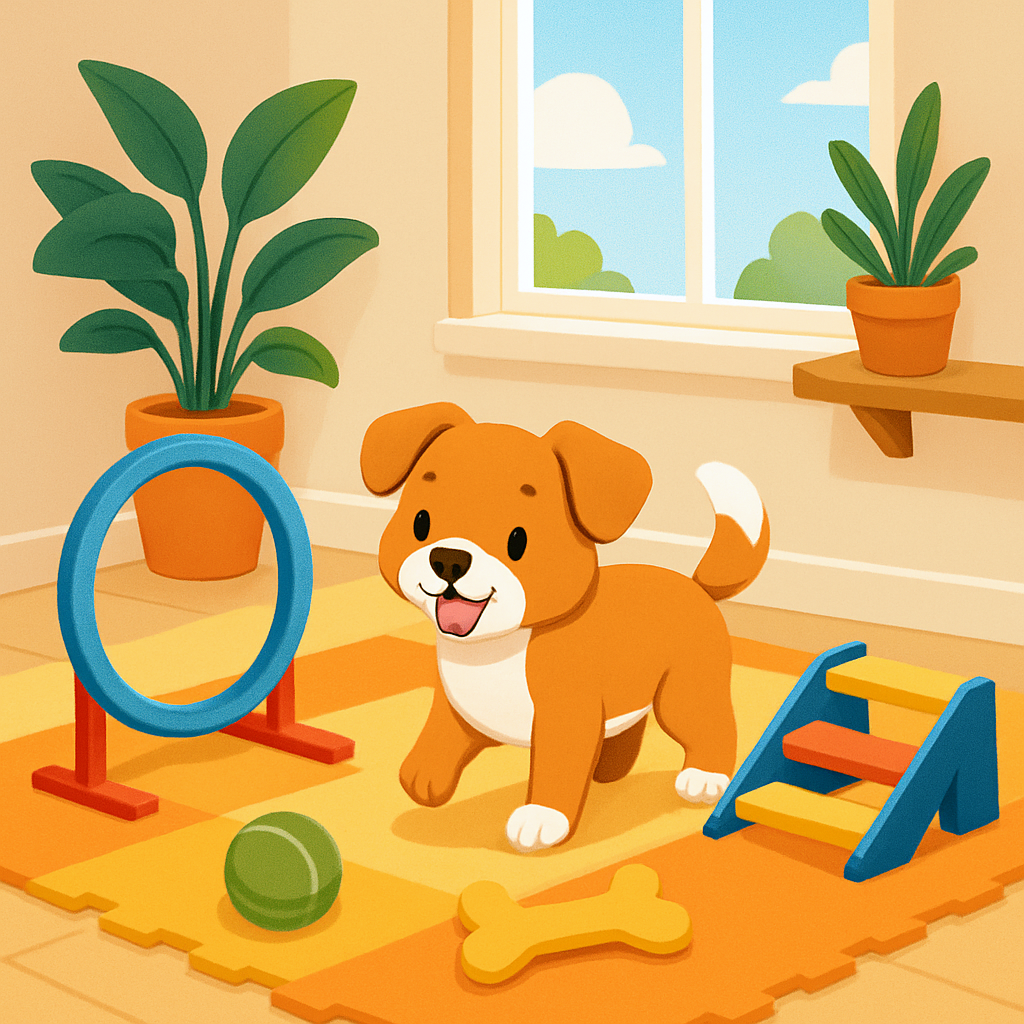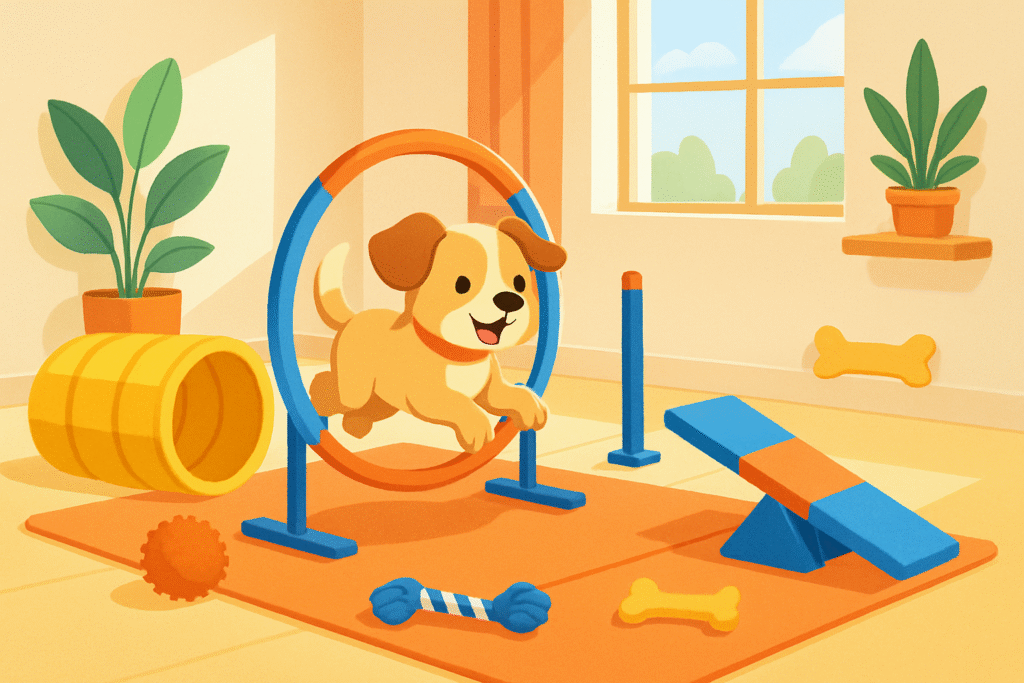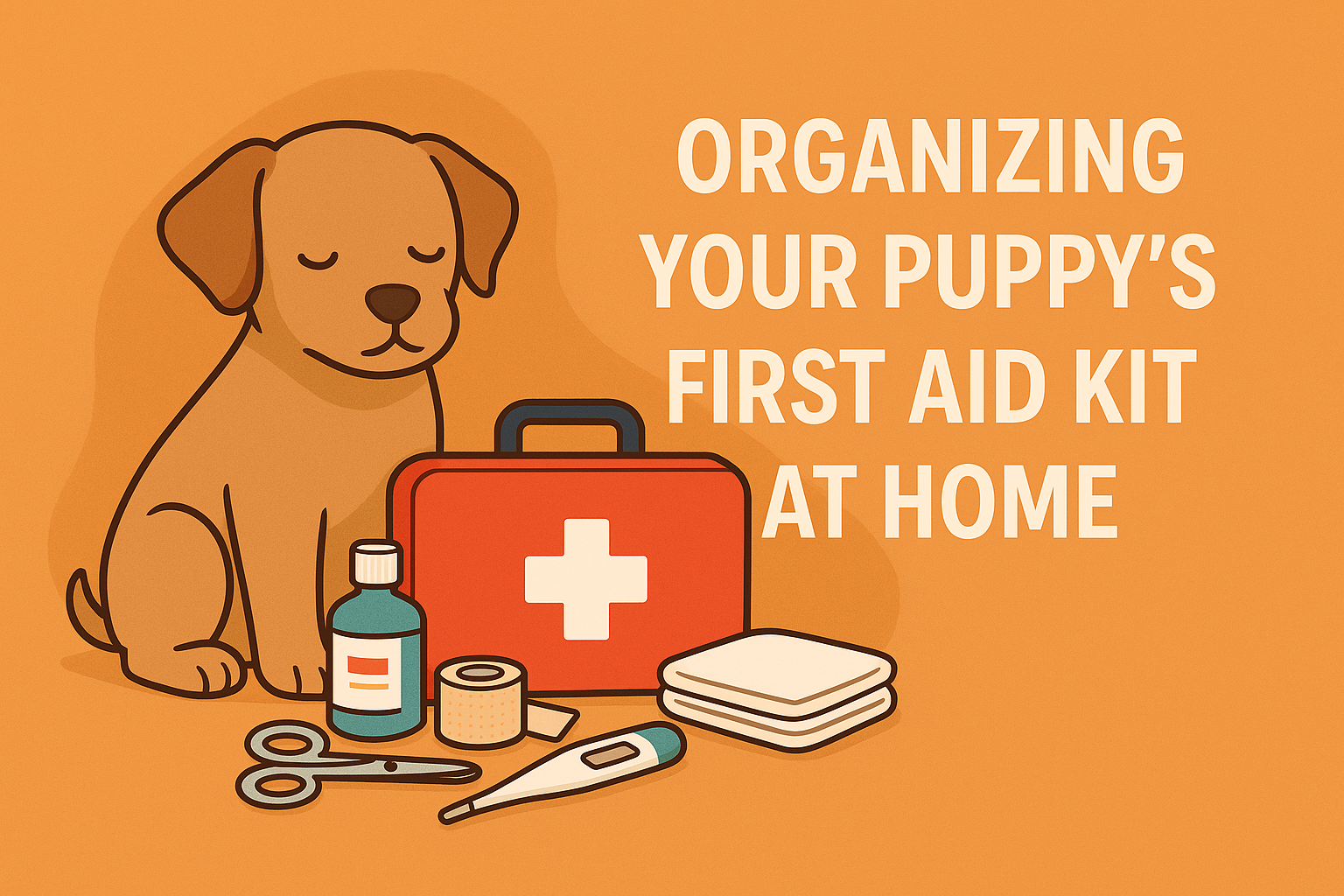Understanding Your Space
To create an effective puppy exercise area in small spaces, it’s essential to first evaluate the available areas you have. Begin by assessing both indoor and outdoor spaces, even if they appear limited. Think creatively about unconventional areas such as balconies or small yards, which can offer fresh air and a change of scenery for your puppy. These spaces can often be transformed with a little imagination and the right equipment, allowing your puppy to explore and exercise safely.
Consider adding planters or protective railings to balconies to ensure safety while providing an exercise area. Similarly, small yards can be sectioned into different zones for play and rest, optimizing the available space. Remember, every little bit helps when creating a conducive environment for your pup’s physical activity.
Essential Equipment for Small Space Puppy Exercise
Equipping your space with the right tools is crucial for effective puppy exercise in confined areas. Portable exercise equipment, like foldable tunnels and compact agility hurdles, can easily be stored when not in use and are perfect for indoor activities. These items help maintain your puppy’s physical health without requiring a large footprint.
Interactive toys are also vital for keeping your puppy mentally stimulated. Puzzle toys, treat dispensers, and interactive balls not only engage their minds but also keep them physically active. Dr. Mary Burch, Director of the American Kennel Club’s Canine Good Citizen program, emphasizes, “Mental stimulation is just as important as physical exercise, especially in small living spaces.” Incorporating these elements into your puppy’s routine helps provide a holistic approach to their daily activities.
Designing an Effective Small Space Exercise Area
When designing your puppy’s exercise area, consider using multi-functional furniture and smart layout ideas to maximize your limited space. Multi-tiered shelving and furniture with built-in pet spaces can help create a dynamic play area without cluttering your home. These can serve as play zones and resting spots, allowing your puppy to enjoy diverse activities in a confined space.
Divide the area into sections for different activities, such as a play zone, a quiet area for rest, and a small area for feeding and hydration. Keep in mind the flow of movement to ensure your puppy can navigate easily and safely between each area. Utilizing vertical space can also provide additional room for play and exploration, making the most of limited square footage.
Safe and Engaging Exercise Activities
Even in small spaces, there are plenty of activities and exercises to keep your puppy entertained and healthy. Indoor exercises such as fetch with soft toys or tug-of-war can be easily adapted to smaller environments. Additionally, teaching your puppy tricks or commands can be a fun way to expend energy mentally and physically.
Traditional puppy exercises, like running or fetch, can be modified for smaller spaces by using lightweight and soft toys that won’t damage your home. Interactive games like hide and seek, where your puppy finds you or a particular object, can also be effective. The key is to keep activities varied to prevent boredom and encourage healthy development.
Managing Challenges in Small Space Exercise
Exercising a puppy in small areas does come with its challenges, particularly regarding noise. Be considerate of neighbors by choosing quiet toys and timing exercise sessions during reasonable hours. Rubber toys and interactive games that don’t involve loud noises can help mitigate this issue.
Safety is also a paramount concern in confined spaces. Ensure that the exercise area is clear of hazards such as sharp objects or wires. Non-slip mats can prevent slips and injuries, providing a safer environment for activities. Regularly check toys and equipment for wear and tear to ensure your puppy’s safety.
Tips for Maintaining a Positive Exercise Routine
Consistency is key to a successful exercise routine, even in small spaces. Set a schedule that incorporates daily exercises and stick to it as much as possible. Routine helps puppies understand what to expect and reduces stress, promoting a positive atmosphere for growth and learning.
Monitor your puppy’s health and adjust activities as they grow. Puppies’ needs evolve rapidly, and what works now may not be suitable in a few months. Consult with your veterinarian regularly to ensure your exercise routine supports your puppy’s development. 🐾
Integrating Socialization in Small Spaces
Socialization is a crucial part of puppy development, even if your space is limited. Arrange playdates with other puppies in safe, controlled environments, or take advantage of local dog parks when possible. These experiences are invaluable for teaching your puppy how to interact with others.
In smaller living spaces, consider inviting a friend with a dog to your home for a low-key play session. This provides exercise and socialization while keeping to a manageable environment. Be sure to supervise interactions to maintain safety and positive experiences.
Conclusion
Creating a rewarding puppy exercise area in small spaces requires creativity and careful planning. By understanding your available space, acquiring suitable equipment, and designing an engaging environment, you can ensure your puppy remains active and healthy. It’s important to encourage and adapt the environment as your puppy grows, enjoying the process of innovation and care in your unique setting. Remember, keeping your puppy’s routine consistent and integrating regular socialization will bring joy and companionship that benefits both you and your puppy.# FAQ for Creating a Puppy Exercise Area in Small Spaces
Why is exercise important for puppies, especially in small spaces?
Exercise is vital for a puppy’s physical, mental, and emotional development. In small spaces, regular exercise helps prevent boredom and destructive behavior, keeping puppies stimulated and happy. Adequate exercise ensures that even in limited environments, puppies grow up to be well-rounded and healthy dogs.
How do I assess my available space for creating a puppy exercise area?
Start by examining both indoor and outdoor spaces, no matter how limited they may seem. Look for areas that can be safely modified, such as balconies or small yards, to accommodate a puppy exercise zone. Creative use of vertical and multi-functional furniture can also help you optimize available space efficiently.
What essential equipment should I consider for a small space puppy exercise area?
Portable and compact equipment like foldable tunnels and lightweight hurdles are ideal for confined spaces as they can be stored easily when not in use. Additionally, toys that provide mental stimulation, such as puzzle toys and treat dispensers, are essential for keeping puppies engaged and active without needing much physical space.
What are some layout ideas for maximizing space in a small puppy exercise area?
Utilize multi-functional furniture such as built-in pet spaces or furniture with storage to create a clean and organized exercise area. Consider designing your layout with distinct zones for play, rest, and feeding, using vertical space to your advantage. Ensuring an easy flow of movement between these zones will make the area more practical and enjoyable for your puppy.
What are some safe exercise activities for puppies in small spaces?
In small spaces, activities like gentle fetch with soft toys and tug-of-war can keep your puppy entertained. You can also engage your puppy in training exercises that involve learning commands or tricks, which stimulates their mind as well as their body. Always ensure that the activities are varied and safe to keep them from becoming monotonous.
How can I handle noise concerns when exercising my puppy in a small space?
Choose quieter toys such as rubber balls or silent treat dispensers to minimize noise. Conduct exercise sessions at times when they are least likely to disturb neighbors, and consider using area rugs or pads to muffle sounds from playful paws.
What safety precautions should I take in a small space puppy exercise area?
Regularly check the area for potential hazards like sharp objects, loose wires, or small items that a puppy might swallow. Use non-slip mats to prevent slipping and injuries during play. Continuously inspect toys and equipment for any wear or damage to ensure your puppy’s safety.
How do I maintain a consistent exercise routine for my puppy in a small space?
Establish a regular exercise schedule, making sure to allocate specific times for play throughout the day. Consistency helps your puppy know what to expect and reinforces good habits. Keep track of your puppy’s growth and adjust the routine accordingly, consulting with your veterinarian to ensure it meets their changing needs.
 How can I incorporate socialization for my puppy in a limited space?
How can I incorporate socialization for my puppy in a limited space?
Organize playdates with other puppies in safe settings or visit local dog parks to allow your puppy to interact and socialize. Even in a small space, inviting a friend with a dog over for a controlled play session can be beneficial. Always supervise these interactions to ensure they stay positive and safe.
What should I keep in mind as my puppy grows in a small space?
As your puppy grows, their exercise and space needs will change, so regularly assess your area and adapt the layout and activities as needed. Continuously innovate and adjust your puppy’s environment to cater for their evolving developmental needs. Keeping a close eye on their health and behavior will help you create a nurturing and stimulating environment throughout their growth stages.


 How can I incorporate socialization for my puppy in a limited space?
How can I incorporate socialization for my puppy in a limited space?





